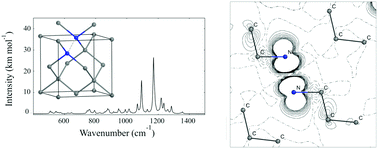N2 positively charged defects in diamond. A quantum mechanical investigation of the structural, electronic, EPR and vibrational properties†
Abstract
EPR data of the positively charged N2 defect (N+2) are reported from all-electron calculations based on the B3LYP hybrid functional using a local (Gaussian type) basis set, within a supercell scheme, as implemented in the CRYSTAL code. The Fermi contact Aiso term, the components of the hyperfine coupling tensor,  , and the electric field gradient
, and the electric field gradient  (only P‖ is available) are all in excellent agreement with two independent sets of experimental data, with errors of less than 4%. The equilibrium geometry, electronic structure, and IR and Raman spectra are also computed, where the two spectra are compared with those of the neutral N2 and double positive N++2, both of which have closed shell ground states. In particular the IR and Raman spectra of the three species exhibit important differences. Information on the charge, spin and geometry of defective species derived from experimental EPR data are based mostly on relatively simple models; here they are obtained directly from rigorous quantum mechanical simulations. It is shown that the extrapolation from the experimental EPR data can lead to relatively serious errors.
(only P‖ is available) are all in excellent agreement with two independent sets of experimental data, with errors of less than 4%. The equilibrium geometry, electronic structure, and IR and Raman spectra are also computed, where the two spectra are compared with those of the neutral N2 and double positive N++2, both of which have closed shell ground states. In particular the IR and Raman spectra of the three species exhibit important differences. Information on the charge, spin and geometry of defective species derived from experimental EPR data are based mostly on relatively simple models; here they are obtained directly from rigorous quantum mechanical simulations. It is shown that the extrapolation from the experimental EPR data can lead to relatively serious errors.



 Please wait while we load your content...
Please wait while we load your content...